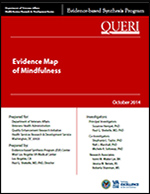
Principal Investigators:
Susanne Hempel, PhD;
Paul G. Shekelle, MD, PhD
Co-Investigator:
Stephanie L. Taylor, PhD;
Nell J. Marshall, PhD;
Michele R. Solloway, PhD
Download PDF: Report
Many Veterans desire complementary and alternative medicine or integrative medicine modalities, both for treatment and for the promotion of wellness. Given the VA's desire to promote evidence-based practice, this evidence mapping project aims to help provide guidance to VA leadership about the distribution of evidence on mindfulness approaches.
Mindfulness, often translated from Sanskrit to mean "awareness," is an ancient Buddhist concept and, although many different forms and definitions exist, a central aspect of the practice is the intention to be more aware and engaged in the present moment. Two components can be differentiated: the self-regulation of attention so that it is maintained on immediate experiences (thereby allowing for increased recognition of mental events in the present moment) and adopting a particular orientation toward experiences in the present moment (an orientation that is characterized by curiosity, openness, and acceptance). Kabat-Zinn is often credited with popularizing mindfulness in the US by creating a mindfulness-based stress reduction (MBSR) program for treating chronic disease which created institutional capacity for using mindfulness-approaches in clinical settings. Evaluations of a large number and variety of mindfulness interventions have been published, there is only limited agreement on how to define mindfulness interventions, and formats and components vary across interventions.
Evidence Map of Mindfulness (Management eBrief)
Goldstein KM, Shepherd-Banigan M, Coeytaux RR, et al. Use of mindfulness, meditation and relaxation to treat vasomotor symptoms. Climacteric. 2017;20(2):178-182. http://dx.doi.org/10.1080/13697137.2017.1283685